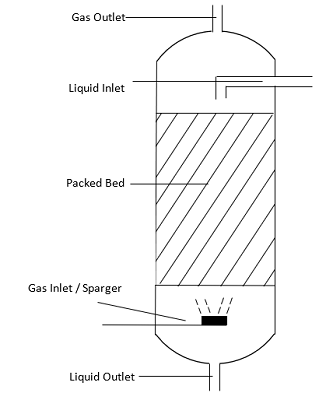Trickle bed reactors are solid-liquid-gas contacting devices wherein a liquid stream flows downward over a bed of catalyst with pressure difference serving as the driving force. The fluid flows over catalyst particles and forms fine films, rivulets, or droplets. The gas stream can either flow concurrent with the liquid or countercurrent to it through the bed. Trickle bed reactors are primarily operated in continuous mode but are sometimes used in semi-batch processes.
General Information
Trickle bed reactors are named as such for their operation in a trickle-flow regime. This regime is characterized by stable and continuous flow of the liquid and gas streams through the bed, similar to laminar flow in a single-phase system. The regime in which the system operates is dependent on the velocities of the liquid and gas streams. Trickle bed reactors can also be run in pulsing, spray, or bubble flow regimes depending on the application.
(Copyright of Parr Instrument Company, Moline, IL)
Equipment Design
A typical trickle bed reactor consists of a tubular tank with a sieve plate or wire mesh near its bottom to support the packed bed, and inlets and outlets for the liquid stream at the top and bottom of the reactor, respectively. The gas inlet can be located at the top or bottom, depending on the process, with the outlet located at the opposite end. A bubble cap, sieve plate distributor, or fine layer of non-reacting particles are placed at the top of the bed to ensure a uniform liquid distribution throughout the bed.
Diagram of a typical trickle bed reactor
A large factor in the overall performance of a trickle bed reactor is the type of packed bed used. The configuration of the bed, whether it be random packing or structured packing, as well as the shape of packing used, affects properties such as pressure drop and the catalyst coating area.
The animation below shows the basic operation of a trickle bed reactor, which contains a fixed bed of catalyst. Liquid reactants (green arrows) and gas phase reactants (yellow arrows) continuously enter the reactor and flow through the catalyst bed. The liquid and gas reactants react at the catalyst, and the products are removed continuously.
Depending on the application, alternatives to the standard trickle bed reactor design might be necessary to attain different reactor characteristics. For example:
- Monolith trickle bed reactors use a channeled slab of ceramic or metallic material coated in a catalyst layer. This design allows for a far lower pressure drop and eliminates diffusion as a limiting factor to the reaction.
- Micro-trickle bed reactors use very small characteristic length scales to allow better control of reaction parameters and enhance process safety.
Usage Examples
Trickle bed reactors play a large role in hydroprocessing in the petroleum industry to generate cleaner fuels. Liquid petroleum flows with high-pressure hydrogen gas at relatively low speeds to prolong the residence time within the system. Reactions at the catalyst surface remove pollutants such as sulfur and nitrogen from the petroleum. These are typically very large reactors that correspond to the large production scales in the industry.
Trickle bed reactors are also useful in some wastewater treatment processes. These reactors are used to oxidize toxic phenol in wastewater to non-toxic carbon dioxide and water. Oxidation reactions are very exothermic, so this application can lead to issues of heat transfer and safety in the system.
Advantages
- Can be used for three-phase reactions
- Lower total energy consumption since solids are stagnant, not suspended in slurry
- Simple to operate under high temperatures and pressures
- Lower catalyst attrition
Disadvantages
- Hot spots may develop due to solvent evaporation
- Channeling may occur, leading to inefficiencies
- Difficult to control vessel parameters
- Lower performance when liquid not uniformly distributed
- Difficult to scale up due to dependence on fluid dynamics of system
Acknowledgments
- Parr Instrument Company, Moline, IL
References
- Fogler, Scott H. Elements of Chemical Reaction Engineering. 5th ed. Englewood Cliffs, NJ: Prentice-Hall, 2016. Print.
- Hill, Charles G., Jr. An Introduction to Chemical Engineering Kinetics and Reactor Design. New York: John Wiley & Sons, Inc. 1977. Print.
- Honda, Gregory S. The Hydrodynamics of Trickle Bed Reactors. Ann Arbor, MI: ProQuest LLC. 2016. Print.
- Ranade, Vivek V. Raghunath, Chaudhari V. Gunjal, Prashant R. Trickle Bed Reactors: Reactor Engineering and Applications. Kidllington, Oxford: Elsevier B.V. 2011. Print.
- Walas, Stanley M. Chemical Process Equipment: Selection and Design. Boston: Butterworth-Heinemann, 1990. Print.
Developers
- Sam Catalano
- Alex Wozniack
- Joel Holland


